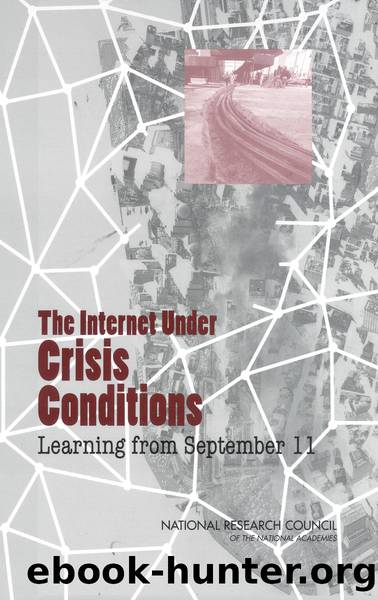The Internet Under Crisis Conditions: Learning from September 11 by National Research Council of the National Academies

Author:National Research Council of the National Academies
Language: eng
Format: epub
Tags: Computers and Information Technology : Internet and Networking
Publisher: NATIONAL ACADEMY PRESS
Published: 2003-01-31T00:00:00+00:00
Cellular Telephones
As word of the attacks spread, the cellular telephone system in the northeastern United States began to be heavily loaded. Nationally, call volume rose 50 percent above normal. One can compare this rate with the 30 percent increase typical on Motherâs Day, the canonical example of an exceptional calling day. Cellular telephone systems are usually engineered to support traffic during busy hours with only about 4 percent of calls being blocked (given a busy signal).
Regionally, the experience was even more dramatic. New York City had a 400 percent increase in call attempts during the day. At about 11:00 A.M., the volume was up 1,300 percent for at least one major carrier. Washington, D.C., had a 125 percent increase for the day. New England as a whole saw a 75 percent increase. The cellular system was not engineered for these loads, so call-blocking rates grew accordingly. In New York, 75 percent of calls were blocked (92 percent at the morning peak). In Washington, D.C., 56 percent of calls were blocked.
Wireless Internetâusing such devices as Research in Motionâs Blackberryâalso rose on September 11. Traffic surged by 60 percent around 10:00 A.M. and stayed high through the early afternoon.7
7From reports by carriers to the Federal Communications Commission.
Download
This site does not store any files on its server. We only index and link to content provided by other sites. Please contact the content providers to delete copyright contents if any and email us, we'll remove relevant links or contents immediately.
Deep Learning with Python by François Chollet(15032)
The Mikado Method by Ola Ellnestam Daniel Brolund(12292)
Hello! Python by Anthony Briggs(12183)
OCA Java SE 8 Programmer I Certification Guide by Mala Gupta(11550)
Dependency Injection in .NET by Mark Seemann(11336)
A Developer's Guide to Building Resilient Cloud Applications with Azure by Hamida Rebai Trabelsi(10530)
Algorithms of the Intelligent Web by Haralambos Marmanis;Dmitry Babenko(10150)
The Well-Grounded Java Developer by Benjamin J. Evans Martijn Verburg(9811)
Grails in Action by Glen Smith Peter Ledbrook(9479)
Secrets of the JavaScript Ninja by John Resig Bear Bibeault(9045)
Hit Refresh by Satya Nadella(9039)
Sass and Compass in Action by Wynn Netherland Nathan Weizenbaum Chris Eppstein Brandon Mathis(9032)
The Kubernetes Operator Framework Book by Michael Dame(8473)
Test-Driven iOS Development with Swift 4 by Dominik Hauser(8437)
Exploring Deepfakes by Bryan Lyon and Matt Tora(8298)
Robo-Advisor with Python by Aki Ranin(8251)
Practical Computer Architecture with Python and ARM by Alan Clements(8225)
Implementing Enterprise Observability for Success by Manisha Agrawal and Karun Krishnannair(8193)
Building Low Latency Applications with C++ by Sourav Ghosh(8099)
